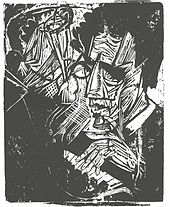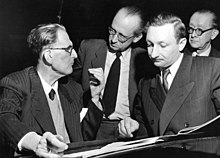Otto Klemperer
Otto Klemperer (born Otto Nossan Klemperer ; born May 14, 1885 in Breslau ; † July 6, 1973 in Zurich ) was a German conductor and composer . He is considered one of the great conductors of the 20th century.
Life
Youth and first years of employment


Klemperer was born in the Silesian town of Breslau as the second of three children to Nathan and Ida Klemperer. He had a younger and an older sister. The Romanist Victor Klemperer is his cousin. Being at the Dr. Hoch's Conservatory in Frankfurt he sat begun studying in Berlin at the Stern Conservatory in James Kwast (piano) and Hans Pfitzner (composition and orchestral conducting) continued. When he was allowed to conduct the Fernorchester in Gustav Mahler's 2nd Symphony under Oskar Fried in 1905 , he met the composer personally. The two became friends, and in 1907, on Mahler's recommendation, Klemperer got the position of choirmaster and later Kapellmeister at the German State Theater in Prague . In 1910 he assisted Mahler in the world premiere of his 8th symphony .
Theater career in the German Empire
In his further career he came to the Stadt-Theater Hamburg from 1910 to 1912 and the Stadttheater Barmen from 1912 to 1913 . From 1914 to 1917 he was Pfitzner's deputy at the City Theater in Strasbourg and chief conductor of the Strasbourg Philharmonic . This was followed by a position as Kapellmeister, later as General Music Director at the Cologne Opera from 1917 to 1924.
Through the Catholic clergyman Franz Xaver Münch , with whom he was on friendly terms, he came into contact with the Maria Laach Abbey in 1918 and converted from Jewish to Catholicism in 1919. In 1919 he married the singer Johanna Geisler in Cologne .
From 1924 to 1927 Klemperer worked as general music director in Wiesbaden , his best time, as he later stated. During this time he undertook a. a. Travel to the Soviet Union . He then headed the Kroll Opera in Berlin until 1931 . Klemperer became famous for his performances of contemporary works, such as Arnold Schönberg's The Happy Hand , Leoš Janáček's opera From a House of the Dead , Igor Stravinsky's Oedipus Rex and Paul Hindemith's Cardillac .
Due to his sensational performances between 1918 and 1933, Klemperer earned a reputation as one of the great conductors of the German Reich.
Emigration in 1933
In 1933 Klemperer was called a " cultural Bolshevik " and was banned from performing. In the same year he emigrated to the USA, where he became conductor with the Los Angeles Philharmonic Orchestra . In the Lexicon of Jews in Music of 1940 he was ostracized with the following statement: "Klemperer saw his main task in the deliberate distortion of German masterpieces." During his time in America, he concentrated primarily on the works of German classics and romantics such as Beethoven , Brahms and Mahler .
Return to Europe in 1947

After the end of the Second World War he returned to Europe and became musical director of the State Opera in Budapest (1947–1950). After three years with the Montreal Symphony Orchestra , among others , he settled in Switzerland in 1954 and worked mainly with the Philharmonia Orchestra London, where he was appointed chief conductor for life in 1959.
He had memorable operas at the Budapest Opera , but there was also one of the scandals typical of Klemperer: at the end of the Grail story in a performance of Lohengrin on October 24, 1948, the enthusiastic audience applauded the outstanding performance by József Simándy for one to force capo. Klemperer, who saw the musical flow interrupted, reacted angrily after the audience still did not want to end with thunderous applause by breaking off his conducting, turning around and shouting to the audience: "Cheekiness" and then leaving the orchestra pit. The audience shouted “Otto, Otto”, shortly afterwards he came back and conducted the opera to the end.
The document is still available today on a CD from Grammofono 2000 and from Archiphon.
In Doctor Faustus from 1947, Thomas Mann had the world premiere of Leverkühn's Opus Apocalipsis cum Figuris conducted by Klemperer. Klemperer said: "A very good work, I'm in!"
The composer Klemperer
Although Klemperer was less well known as a composer, he wrote a large number of his own works, including six symphonies , a mass , nine string quartets , around a hundred songs and an opera called Das Ziel .
There is a CD production of his symphonies No. 1 and No. 2 as well as four symphonic works (Merry Waltz, Marcia funèbre, Recollections, Scherzo), played by the State Philharmonic of Rhineland-Palatinate under the direction of Alun Francis (cpo 999 987 -2).
Last years of life
In his later life, Klemperer suffered from partial paralysis , which probably resulted from an operation in 1939 when he had been treated for a tumor in the head. He was also suffering from bipolar disorder (manic-depressive illness), for which he was temporarily in clinical treatment. Nevertheless, he remained active until 1971. In his final years he has "recently returned to the faith of the fathers, diligently attending the temple, and performing the rites." After 1971 he withdrew from the public eye until he died in Zurich in 1973. He was buried there in the Israelite cemetery in Oberer Friesenberg .
Private life
From 1912 to 1913 Klemperer had a liaison with the soprano Elisabeth Schumann , who was married to the architect Walther Puritz at the time.
He was married to the singer Johanna Geisler from 1919 until her death in 1956 . The children Werner Klemperer (1920–2000) and Lotte Klemperer (1923–2003) emerged from the marriage. His daughter Lotte worked for him until the end as a manager, secretary and supervisor. His son Werner was best known as an actor in Hollywood for his role as Colonel Wilhelm Klink in the sitcom A Cage Full of Heroes .
Honors
- 1958: Large Cross of Merit with Star of the Federal Republic of Germany
- 1963: Grammy in the category "Best Classical Performance - Choral Other Than Opera" (Bach: Matthäus-Passion) (with the Philharmonia Orchestra )
- 1964: Honorary membership of the Beethoven House in Bonn
- 1967: Arthur Nikisch Prize
literature
- Peter Heyworth (Ed.): Conversations with Klemperer . S. Fischer Verlag, Frankfurt am Main 1974, ISBN 3-10-033501-5 .
- Peter Heyworth: Otto Klemperer. Conductor of the Republic 1885–1933. Siedler, Berlin 1988, ISBN 3-88680-166-7 .
- Peter Heyworth: Otto Klemperer. His Life and Times: 1933-1973. Cambridge University Press, Cambridge 1996, ISBN 0-521-24488-9 .
- Charles Osborne: Otto Klemperer - Just say Otto. Piper, Munich 1981, ISBN 3-492-02430-0 .
- Gesine Schröder: Bruckner's eighth - Klemperer - light step. On the relationship between conducting and analysis . in: Music Theory . Issue 1/2003, pp. 65-72, Munich 2003. ISSN 0177-4182 .
- Eva Weissweiler : Otto Klemperer: a German-Jewish artist's life. Kiepenheuer & Witsch, Cologne 2010, ISBN 978-3-462-04179-8 .
- Anton Würz : Klemperer, Otto. In: New German Biography (NDB). Volume 12, Duncker & Humblot, Berlin 1980, ISBN 3-428-00193-1 , p. 37 f. ( Digitized version ).
- Antony Beaumont (Ed.): " Excuse me, I cannot speak high." Letters from Otto Klemperer 1906–1973. Ed. Text + criticism, Munich 2012, ISBN 978-3-86916-101-3 .
Web links
- Klemperer, O. (1792). (Manuscript / Mixed Material) Retrieved from the Library of Congress
- Works by and about Otto Klemperer in the catalog of the German National Library
- Newspaper article about Otto Klemperer in the 20th century press kit of the ZBW - Leibniz Information Center for Economics .
- Otto Klemperer on arts in exile
- Article on Otto Klemperer's 125th birthday in "haGalil - Jewish life online"
References and comments
- ^ Peter Heyworth: Otto Klemperer: Conductor of the Republic 1885 - 1933 . 1st edition. Siedler, Berlin 1988, ISBN 3-88680-166-7 , p. 11 ff .
- ↑ Peter Heyworth therefore called him in his later biography "Conductor of the Republic".
- ^ Ernst Klee : The cultural lexicon for the Third Reich. Who was what before and after 1945. S. Fischer, Frankfurt am Main 2007, ISBN 978-3-10-039326-5 .
- ^ Jacques Darmaun: Thomas Mann et les Juifs. (EA: Bern: Peter Lang 1995.) German: Niemeyer, Tübingen 2003, p. 233.
- ^ Eva Weissweiler: Otto Klemperer - a German-Jewish artist's life. Cologne 2010, p. 271.
- ↑ Katja Mann 1967 in a letter to her brother Klaus Pringsheim dated June 24, 1967, quoted in: Inge and Walter Jens : Frau Thomas Mann. Rowohlt (TB), Reinbek 2004, p. 289.
- ↑ Hamburg Years in Die Welt (2012)
| personal data | |
|---|---|
| SURNAME | Klemperer, Otto |
| BRIEF DESCRIPTION | German conductor and composer |
| DATE OF BIRTH | May 14, 1885 |
| PLACE OF BIRTH | Wroclaw |
| DATE OF DEATH | July 6, 1973 |
| Place of death | Zurich |



